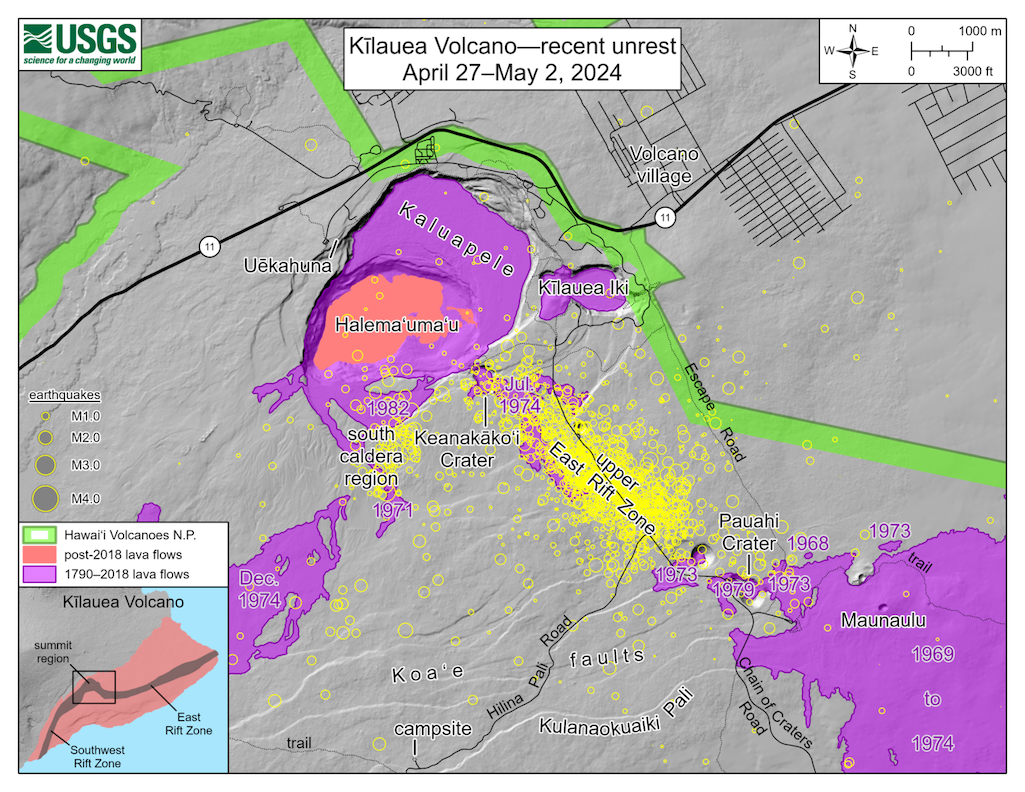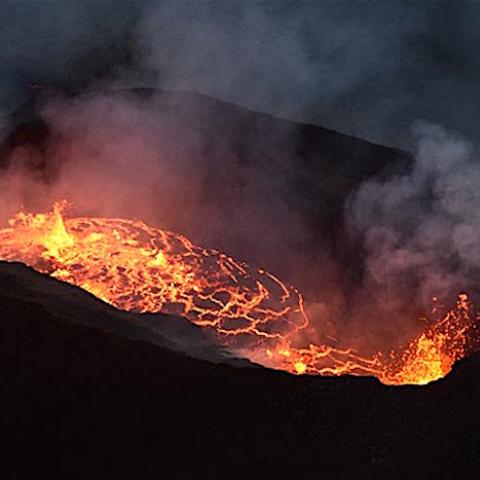
This map depicts recent unrest at Kīlauea volcano. Yellow circles mark the locations of approximately 1,600 earthquakes that have occurred between April 27 and May 2, 2024, as the upper East Rift Zone reacts to pressurization of magma chambers beneath the summit region of Kīlauea. Most earthquakes have been smaller than magnitude-2, with locations clustering in an area known as the upper East Rift Zone or East Rift connector/USGS
Ongoing earthquakes and growing seismic pressure continue to reflect unrest with the Kīlauea volcano at Hawai'i Volcanoes National Park, but volcanologists say it's impossible to predict if an eruption is imminent.
The activity has been focused on the volcano's East Rift Zone, where a series of "[P]it craters and lava flows ... are evidence of a long history of magma moving along this rift zone pathway."
"Recent earthquakes occurring in the upper East Rift Zone reflect the higher level of pressurization," the Hawaiian Volcano Observatory reported overnight. "The magma storage system beneath Kīlauea has recharged following the intrusion that occurred southwest of the summit in late January–early February of this year. Recent earthquakes occurring in the upper East Rift Zone reflect the higher level of pressurization."
"It is not possible to forecast an exact outcome of this activity," the statement continued. "Based on the pattern of past activity in the upper East Rift Zone, the current activity is much more likely to result in an intrusion rather than an eruption. However, future changes in the location of unrest—and the potential for eruption—could unfold quickly (in days to hours)."
Earlier this week staff at the national park announced a number of public closures due to the volcano's activity. Among them was the Chain of Craters Road from the intersection at Crater Rim Drive, Hilina Pali Road, the Kulanaokuaiki Campground, overnight camping for all coastal sites, the Ka'ū Desaert Trail from the Footprints exhibit, and the Maunaiki Trail.
Hawaiʻi Volcanoes National Park encompasses two of the world’s most active volcanoes —Kīlauea and Mauna Loa — making it distinct among national parks. In 2022, the park closed the summit of Mauna Loa weeks ahead of its historic and nearly two-week-long eruption. As a result, no evacuations or search and rescue missions were necessary.
The Kīlauea volcano last erupted last September, with lava fountains rocketing more than 80 feet into the sky, according to the U.S. Geological Survey.
Kīlauea's disastrous 2018 eruption occurred along the East Rift Zone, and was called by the USGS "the most destructive over the last 200 years in Hawai‘i, with 24 fissures covering an area of over 8,700 acres (35.5 square km) including the addition of 875 acres of new land beyond the old coastline. Over 700 structures and 30 miles (48 km) of roads were covered, displacing many residents. Gas emissions were at the highest levels ever recorded at Kīlauea and impacted much of the State of Hawaii and areas as far away as Guam."
During the past week observatory geologists reported a sharp increase in both seismicity and ground deformation on the flanks of the volcano, "with most seismicity focused along Chain of Craters Road from Luamanu Crater to Pauahi Crater. This activity is reflective of increasing pressurization in the magmatic system underlying the Kīlauea summit region. Current conditions are not indicative of an imminent eruption, but this could change rapidly."
According to the observatory, "more than 1,600 earthquakes have occurred in the six days since April 27. These were initially concentrated beneath the upper East Rift Zone along Chain of Craters Road between Puhimau Crater and Hilina Pali Road but have since expanded northwestward to Luamanu Crater and Keanakākoʻi Crater, and southeastward to Pauahi Crater. Approximately 300 more earthquakes have been located south of Halemaʻumaʻu within the outer boundaries of Kaluapele (Kīlauea caldera)."
The geologists outlined several scenarios that could play out in the coming days to weeks:
Magma continues to accumulate in reservoirs beneath Kīlauea’s summit. Earthquakes and ground deformation continue at varying rates, but no eruption occurs.
Magma continues to accumulate in reservoirs beneath Kīlauea’s summit, resulting in magma moving into a new area via a dike intrusion. This could occur to the southeast, in the region of elevated earthquake activity, or return to the southwest (similar to what occurred during late January–early February of 2024). In this scenario, the geologists said they would expect to see accelerated rates of ground deformation and earthquakes in the direction of the intrusion as it occurs, along with summit deflation.
Magma continues to accumulate in the Kīlauea summit region, with an eventual eruption inside the caldera, similar to recent eruptions at Halema‘uma‘u. In this scenario, they said they would expect to see signs of the magma reservoir beneath Halema‘uma‘u rapidly pressurizing prior to accelerated rates of ground deformation and earthquakes beneath the caldera 1–2 hours before lava reaches the surface.
Magma continues to accumulate beneath Kīlauea’s summit region, with an eventual eruption outside of the caldera in the upper portions of one of the rift zones. In this scenario, the geologists said they would expect to see earthquake locations migrating away from the caldera, followed by accelerating rates of ground deformation and earthquakes 1–2 hours before lava reaches the surface.




 Support Essential Coverage of Essential Places
Support Essential Coverage of Essential Places







Add comment